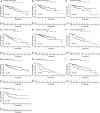Identification of a Novel Glycosyltransferase Prognostic Signature in Hepatocellular Carcinoma Based on LASSO Algorithm
- PMID: 35356430
- PMCID: PMC8959637
- DOI: 10.3389/fgene.2022.823728
Identification of a Novel Glycosyltransferase Prognostic Signature in Hepatocellular Carcinoma Based on LASSO Algorithm
Abstract
Although many prognostic models have been developed to help determine personalized prognoses and treatments, the predictive efficiency of these prognostic models in hepatocellular carcinoma (HCC), which is a highly heterogeneous malignancy, is less than ideal. Recently, aberrant glycosylation has been demonstrated to universally participate in tumour initiation and progression, suggesting that dysregulation of glycosyltransferases can serve as novel cancer biomarkers. In this study, a total of 568 RNA-sequencing datasets of HCC from the TCGA database and ICGC database were analysed and integrated via bioinformatic methods. LASSO regression analysis was applied to construct a prognostic signature. Kaplan-Meier survival, ROC curve, nomogram, and univariate and multivariate Cox regression analyses were performed to assess the predictive efficiency of the prognostic signature. GSEA and the "CIBERSORT" R package were utilized to further discover the potential biological mechanism of the prognostic signature. Meanwhile, the differential expression of the prognostic signature was verified by western blot, qRT-PCR and immunohistochemical staining derived from the HPA. Ultimately, we constructed a prognostic signature in HCC based on a combination of six glycosyltransferases, whose prognostic value was evaluated and validated successfully in the testing cohort and the validation cohort. The prognostic signature was identified as an independent unfavourable prognostic factor for OS, and a nomogram including the risk score was established and showed the good performance in predicting OS. Further analysis of the underlying mechanism revealed that the prognostic signature may be potentially associated with metabolic disorders and tumour-infiltrating immune cells.
Keywords: glycosyltransferase; hepatocellular carcinoma; lasso regression analysis; overall survival; prognostic signature.
Copyright © 2022 Zhou, Wang, Du, Deng, Gao and Zhang.
Conflict of interest statement
The authors declare that the research was conducted in the absence of any commercial or financial relationships that could be construed as a potential conflict of interest.
Figures












Similar articles
-
Identification of a six-gene signature predicting overall survival for hepatocellular carcinoma.Cancer Cell Int. 2019 May 21;19:138. doi: 10.1186/s12935-019-0858-2. eCollection 2019. Cancer Cell Int. 2019. PMID: 31139015 Free PMC article.
-
Identification and characterization of a 25-lncRNA prognostic signature for early recurrence in hepatocellular carcinoma.BMC Cancer. 2021 Oct 30;21(1):1165. doi: 10.1186/s12885-021-08827-z. BMC Cancer. 2021. PMID: 34717566 Free PMC article.
-
Development and validation of a robust epithelial-mesenchymal transition (EMT)-related prognostic signature for hepatocellular carcinoma.Clin Res Hepatol Gastroenterol. 2021 Sep;45(5):101587. doi: 10.1016/j.clinre.2020.101587. Epub 2021 Mar 1. Clin Res Hepatol Gastroenterol. 2021. PMID: 33662631
-
Identification and Validation of Pyroptosis-Related Gene Signature to Predict Prognosis and Reveal Immune Infiltration in Hepatocellular Carcinoma.Front Cell Dev Biol. 2021 Nov 8;9:748039. doi: 10.3389/fcell.2021.748039. eCollection 2021. Front Cell Dev Biol. 2021. PMID: 34820376 Free PMC article.
-
Glycosyltransferases in Cancer: Prognostic Biomarkers of Survival in Patient Cohorts and Impact on Malignancy in Experimental Models.Cancers (Basel). 2022 Apr 24;14(9):2128. doi: 10.3390/cancers14092128. Cancers (Basel). 2022. PMID: 35565254 Free PMC article. Review.
Cited by
-
Integrating TCGA and Single-Cell Sequencing Data for Hepatocellular Carcinoma: A Novel Glycosylation (GLY)/Tumor Microenvironment (TME) Classifier to Predict Prognosis and Immunotherapy Response.Metabolites. 2024 Jan 13;14(1):51. doi: 10.3390/metabo14010051. Metabolites. 2024. PMID: 38248854 Free PMC article.
-
Identification and Validation of Necroptosis-Related LncRNA Signature in Hepatocellular Carcinoma for Prognosis Estimation and Microenvironment Status.Front Genet. 2022 Jun 8;13:898507. doi: 10.3389/fgene.2022.898507. eCollection 2022. Front Genet. 2022. PMID: 35754846 Free PMC article.
-
Glycosylation: mechanisms, biological functions and clinical implications.Signal Transduct Target Ther. 2024 Aug 5;9(1):194. doi: 10.1038/s41392-024-01886-1. Signal Transduct Target Ther. 2024. PMID: 39098853 Free PMC article. Review.
-
Comprehensive analysis of the role of immune-related PANoptosis lncRNA model in renal clear cell carcinoma based on RNA transcriptome and single-cell sequencing.Oncol Res. 2023 Jun 27;31(4):543-567. doi: 10.32604/or.2023.029563. eCollection 2023. Oncol Res. 2023. PMID: 37415739 Free PMC article.
References
-
- Barré L., Venkatesan N., Magdalou J., Netter P., Fournel-Gigleux S., Ouzzine M., et al. (2006). Evidence of Calcium‐dependent Pathway in the Regulation of Human β1,3‐glucuronosyltransferase‐1 (GlcAT‐I) Gene Expression: a Key Enzyme in Proteoglycan Synthesis. FASEB j. 20 (10), 1692–1694. 10.1096/fj.05-5073fje - DOI - PubMed
-
- Chen C.-H., Wang S.-H., Liu C.-H., Wu Y.-L., Wang W.-J., Huang J., et al. (2014). β-1,4-Galactosyltransferase III Suppresses β1 Integrin-Mediated Invasive Phenotypes and Negatively Correlates with Metastasis in Colorectal Cancer. Carcinogenesis 35 (6), 1258–1266. 10.1093/carcin/bgu007 - DOI - PubMed
LinkOut - more resources
Full Text Sources

